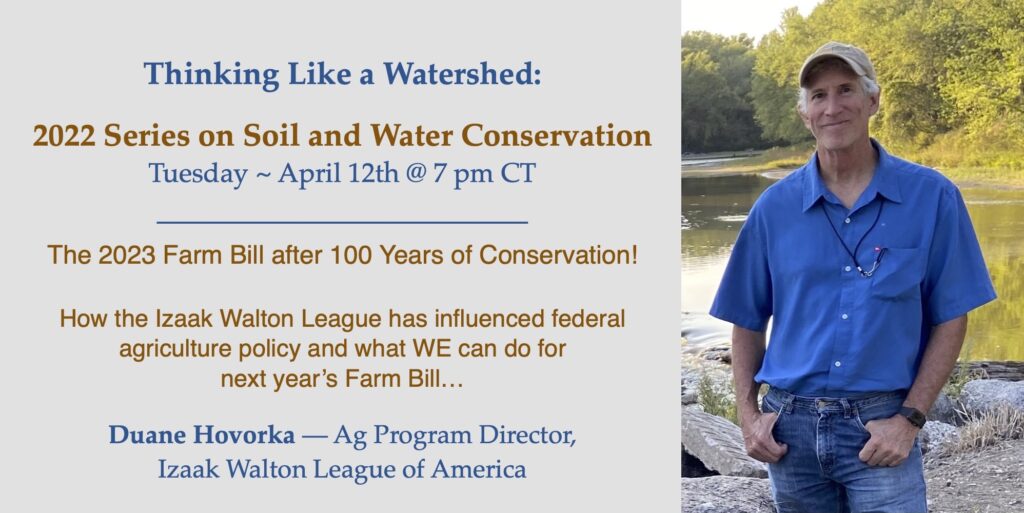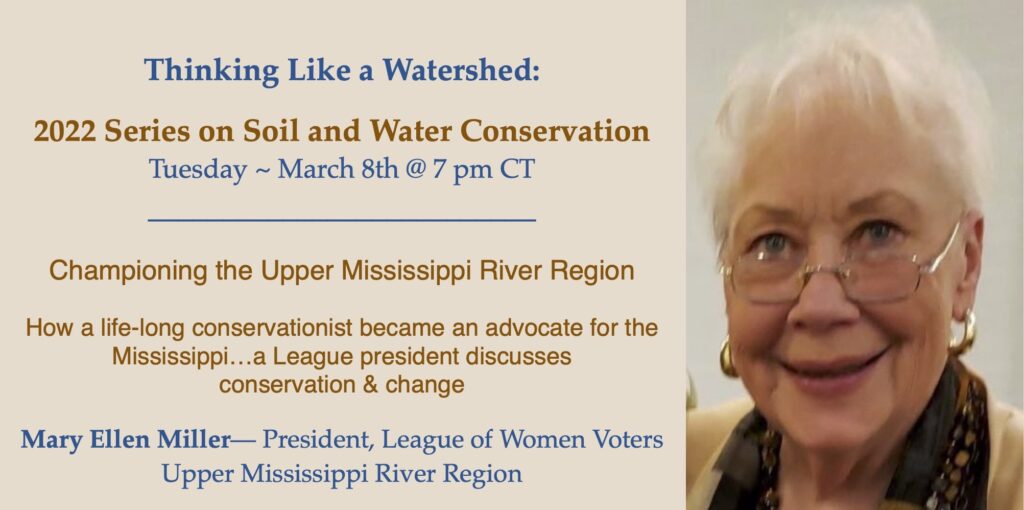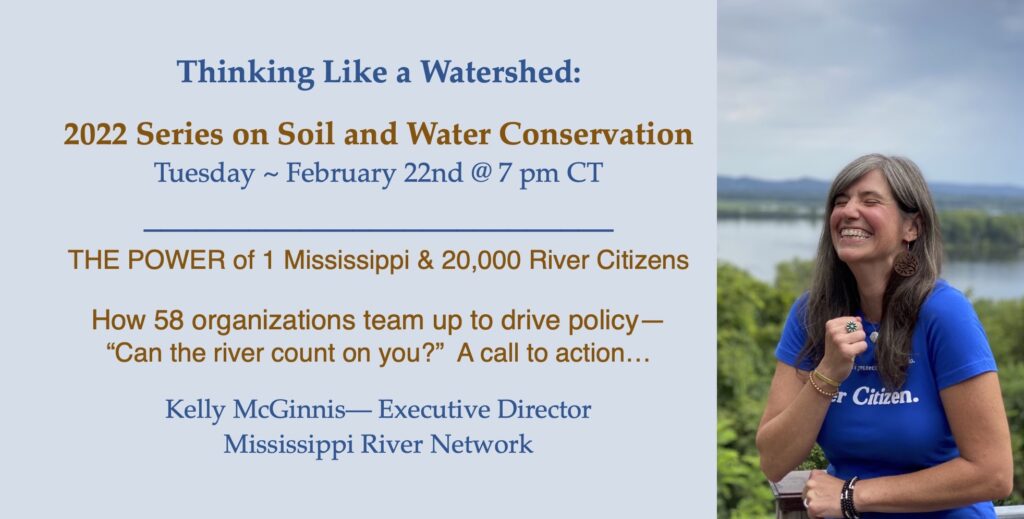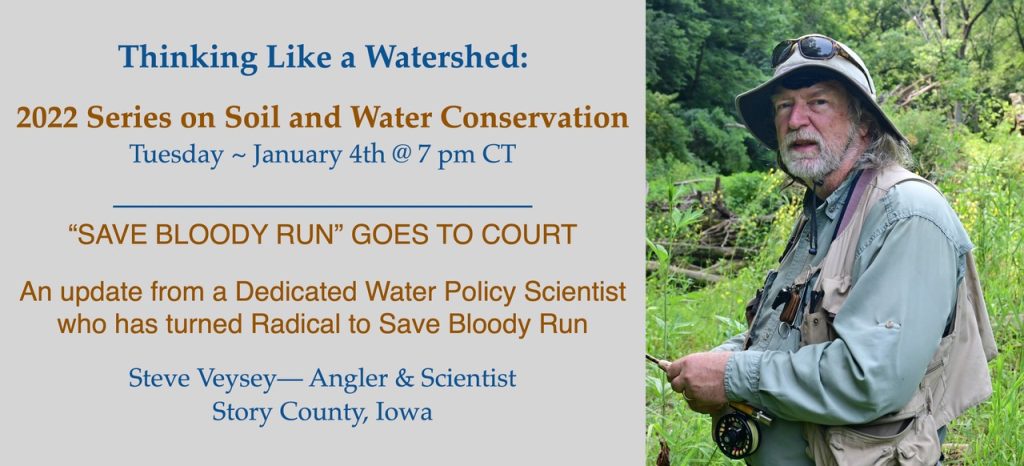But first!
Top of page for deadlines, with details below. Read on for how to act on your priorities:
➢ May 3 at 7 p.m. Central, our Upper Mississippi River Initiative (UMRI) monthly virtual series, “Thinking Like a Watershed” with 4 scientists on shifting policy with E. coli and DNA data. Registration required.
➢ May 21, 2022, at 10:30 a.m., “Does it take an act of Congress to protect the Mississippi?”
➢ Spring stream monitoring is already underway in the Driftless. Want to join in?
“Stream TEAM science is (slowly) shifting policy”
Register in advance for another extraordinary presentation— Our monthly “Thinking Like a Watershed” program continues Tuesday, May 3, 2022, at 7 p.m. Central with a conversation with leaders Larry Dolphin, Bill Buckley, Mark Owens, lifelong members of the Izaak Walton League (IWLA), and Josh Balk, Iowa Department of Natural Resources (DNR) on How E. coli & DNA data changed Mower Co. septic system practices.

After registering, you will receive a confirmation email with the link to join the program on Tuesday, May 3, 2022, starting at 7 p.m. Central.
500 water samples, a specialty lab, and 40 volunteers confirmed in 2017 that untreated human effluent, as well as hog and cattle manure are contributing to E. coli health threats in the headwaters of the Cedar River watershed in south central Minnesota. One outcome is a slow but steady septic system ordinance re-write in Mower County. Three IWLA members who led both the discovery and the push for change will catch us up on their ongoing work with county staff and discuss the power of data wherever you live. They will be joined by an Iowa DNR colleague with his own fecal data points, collected last summer during a cross-state Cedar River Watershed project.
This monthly series is a project of the Upper Mississippi River Initiative (UMRI) of the Izaak Walton League of America, with co-hosts Chris Henning of the Panora Conservation Chapter and Des Moines Chapter Communication Director, Bud Hartley. We feature guests for 30-40 minute presentations that shed daylight on good works done in the name of the Mississippi and its uplands. In this way we uplift our shared goals for a cleaner river, a cared for environment, and kinder communities. Recorded programs are available shortly after they air live.
Farm Bill wish list
Last month’s “Thinking” program featured a summary of listening sessions that brought home what constituents would like to see in next year’s new federal Farm Bill. The ideas were presented by Duane Hovorka, IWLA’s agriculture director, and a recording of his presentation is here. He includes such conclusions as, “Soil is the largest export in Iowa, not corn,” conservation work gets 7% of the current bill, and 75% of it goes to fix farm problems such as manure contamination, erosion, and habitat destruction. Crop insurance gets a third to mitigate loss and to subsidize bad management decisions. Duane’s listening sessions – 2 of them hosted by UMRI in Iowa and Minnesota – brought forth a need to double conservation dollars, to fix crop insurance so that bad behavior is not rewarded but soil health practitioners might be, to address the millions of landowners who do not farm but feel no love from their Farm Bill tax dollars, and the need for regulations. Here are some screenshots; watch the entire program for a history lesson on the now-100-year-old IWLA, the 90-year-old Farm Bill, and what’s in store as the fight for dollars unfolds by next year.

A screenshot from a program on past and future federal farm bills, by Duane Hovorka. The full presentations is here.

Summary sentiments of what constituents want in the next federal Farm Bill, from a presentation by Duane Hovorka. See above for the link.

Summary sentiments of what constituents want in the next federal Farm Bill, from a presentation by Duane Hovorka. See above for the link.

In a brief history of the federal Farm Bill, these terms emerged as not just a relic of the 1930s Dust Bowl. From a presentation by Duane Hovorka. See above for the link.
$102 and a canoe for clean water
Some of our Driftless stream team members paired up with state and local partners to organize a streambank cleanup and do a little promotion for monitoring our public waters. 30-plus people turned out on a windy Earth Day Sunday and in just an hour or so, amassed 21 bags of garbage and yes, $102. We worked alongside a section of Gilmore Creek in Winona, and in the case of 2 intrepid paddlers, at water’s edge as well. The effort was part of UMRI’s collaboration with the travelling “We Are Water” exhibit, which was housed at the Winona County Historical Center until Ap. 25. It now moves to Lake City, MN. Visit We Are Water at the Lake City Public Library April 29 – June 20, 2022. But in the meantime, The Watershed Podcast has released all five Winona-focused episodes (including an episode featuring Whitewater State Park’s Oral History Project). Listen here.

Gilmore Creek – a ditch in places, a muddy backwater in others – meanders through Winona and drops into the Mississippi River right in town. Long time watchers were surprised at the amount of garbage volunteers pulled off the banks in just an hour or so. And we also were surprised at how much we didn’t get to. Photo by Caroline van Schaik
NOTE: A couple of us Driftless SOSers worked as exhibit docents and want to offer a genuine plug for catching this exhibit in any of its 5 remaining sites throughout Minnesota this summer. It proved to be an active and family-friendly story of water, people, and the environment that includes local (where ever the exhibit is housed kind of local) area voices and interactive and creative learning opportunities. There are boards to read, stories to write, and stories to hear via headphones in several languages of our region. There is an interactive screen game to put you in the farmer’s seat since agriculture is a major source of water pollution. There is a puppet theater, children’s books on the topic, maps, excellent diagrams, and a clever illustration of karst topography. It was really a very impressive message of water contamination and solution.
Spring time in the Driftless
By the way, our Driftless stream teams take to eight sites for spring sampling starting now – please contact Caroline van Schaik if you would like to get your hands wet with us.
The League of Women Voters-Upper Mississippi River Region interleague organization (LWV UMRR) hosts its annual meeting May 21, 2022 at 10:30 a.m. with a discussion of innovative answers to that million dollar question, “Does it take an act of Congress to protect the Mississippi?” From a recent blog promoting the event, league communications director Gretchen Sabel writes, “We will cover the Mississippi River Restoration and Resilience initiative (MRRRI), the Saving the Mississippi River Together initiative (SMRT), the Farm Bill reauthorization and a big idea – the notion of an Upper Midwest Compact to protect the waters of the Mississippi from diversion. Our speakers represent organizations that are working to protect the Mississippi.” Details on speakers and to register are found here!
Links to recent “Thinking” presentations

—“The 2023 Farm Bill after 100 Years of Conservation!” Thinking Like a Watershed ~ Duane Hovorka- April 12th, 2022
How the Izaak Walton League has influenced federal agriculture policy and what WE can do for next year’s Farm Bill…with Duane Hovorka, Agriculture Program Director, Izaak Walton League of America

— “Championing the Upper Mississippi River Region” Thinking Like a Watershed ~ Mary Ellen Miller— March 8th, 2022
How a life-long conservationist became an advocate for the Mississippi…a League president discusses conservation & change with Mary Ellen Miller, President, League of Women Voters Upper Mississippi River Region

—“The POWER of 1 Mississippi & 20,000 River Citizens” Thinking Like a Watershed ~ Kelly McGinnis— February 22nd, 2022 How 58 organizations team up to drive policy—“Can the river count on you?” A call to action…

Photo by: David Thoreson
— “Save Bloody Run Goes to Court” Thinking Like a Watershed ~ Steve Veysey— January 4th, 2022 An update from a Dedicated Water Policy Scientist who has turned Radical to Save Bloody Run.
—“Heartland Heroines” Thinking Like a Watershed ~ Robin Moore & Denise O’Brien— June 1, 2021 How two savvy conservationists empower working farm landowners to put their inner land ethic to work.
—“Planting Seeds to Grow Vibrant Communities” Thinking Like a Watershed ~ Chris Deal & Art Cullen— May 4, 2021 How Jefferson, Iowa’s Chris Deal is working with California Rep. Ro Khanna and others to grow vibrant rural communities in the Heartland with perspectives from Pulitzer Prize—winning journalist and editor of The Storm Lake Times, Art Cullen.
—“Watershed Bridges— Green to Blue” Thinking Like a Watershed ~ Vicki Nichols Goldstein & Seth Watkins— April 6, 2021 How improving soil health and water quality in Iowa and other inland states benefit watersheds that provide critical services from land to sea.
—“Local Heroes in Howard County” Thinking Like a Watershed ~ Neil Shaffer & Hunter Slifka— March 2, 2021 How they have incorporated several thousand acres of land under conservation programs–the largest percentage in Iowa.
—“The Accidental Conservationist” Thinking Like a Watershed ~ Wayne Fredericks— February 2, 2021 How an Iowa Farmer is Improving Natural Capital while Increasing Profits with Conservationist and Farmer, Wayne Fredericks from Mitchell County, Iowa.
